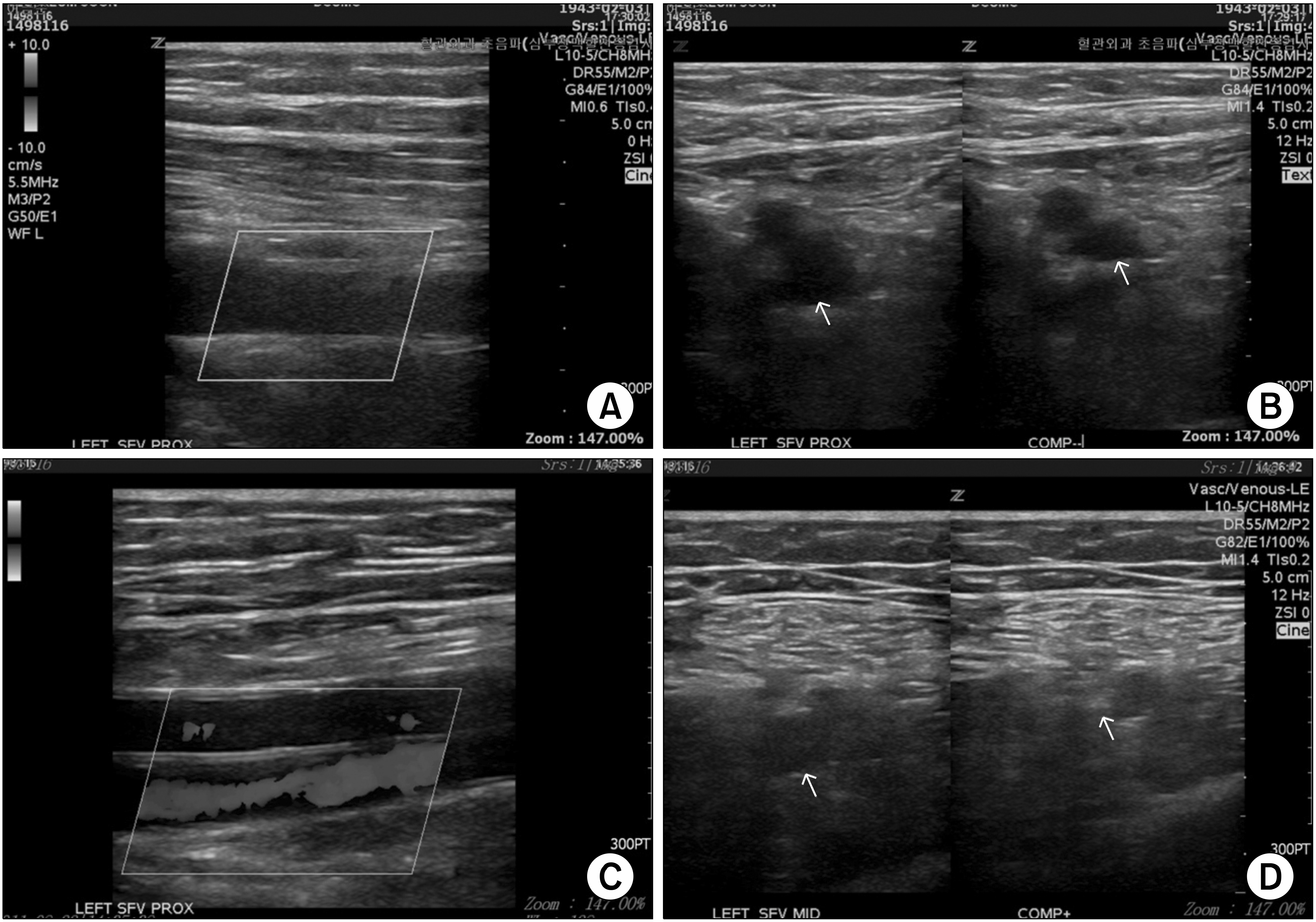1. Prandoni P, Noventa F, Ghirarduzzi A, Pengo V, Bernardi E, Pesavento R, et al. 2007; The risk of recurrent venous thromboembolism after discontinuing anticoagulation in patients with acute proximal deep vein thrombosis or pulmonary embolism. A prospective cohort study in 1,626 patients. Haematologica. 92:199–205. DOI:
10.3324/haematol.10516. PMID:
17296569.

2. Iorio A, Kearon C, Filippucci E, Marcucci M, Macura A, Pengo V, et al. 2010; Risk of recurrence after a first episode of symptomatic venous thromboembolism provoked by a transient risk factor: a systematic review. Arch Intern Med. 170:1710–6. DOI:
10.1001/archinternmed.2010.367. PMID:
20975016.
3. Prandoni P, Lensing AW, Prins MH, Bernardi E, Marchiori A, Bagatella P, et al. 2002; Residual venous thrombosis as a predictive factor of recurrent venous thromboembolism. Ann Intern Med. 137:955–60. DOI:
10.7326/0003-4819-137-12-200212170-00008. PMID:
12484710.

4. Young L, Ockelford P, Milne D, Rolfe-Vyson V, Mckelvie S, Harper P. 2006; Post-treatment residual thrombus increases the risk of recurrent deep vein thrombosis and mortality. J Thromb Haemost. 4:1919–24. DOI:
10.1111/j.1538-7836.2006.02120.x. PMID:
16836658.

5. Kahn SR, Shrier I, Julian JA, Ducruet T, Arsenault L, Miron MJ, et al. 2008; Determinants and time course of the postthrombotic syndrome after acute deep venous thrombosis. Ann Intern Med. 149:698–707. DOI:
10.7326/0003-4819-149-10-200811180-00004. PMID:
19017588.

6. Killewich LA, Bedford GR, Beach KW, Strandness DE Jr. 1989; Spontaneous lysis of deep venous thrombi: rate and outcome. J Vasc Surg. 9:89–97. DOI:
10.1016/0741-5214(89)90223-1. PMID:
2911146.

8. Caprini JA, Arcelus JI, Reyna JJ, Motykie GD, Mohktee D, Zebala LP, et al. 1999; Deep vein thrombosis outcome and the level of oral anticoagulation therapy. J Vasc Surg. 30:805–11. DOI:
10.1016/S0741-5214(99)70004-2. PMID:
10550177.

9. Agnelli G, Buller HR, Cohen A, Curto M, Gallus AS, Johnson M, et al. 2013; Oral apixaban for the treatment of acute venous thromboembolism. N Engl J Med. 369:799–808. DOI:
10.1056/NEJMoa1302507. PMID:
23808982.

10. Bauersachs R, Berkowitz SD, Brenner B, Buller HR, Decousus H, Gallus AS, et al. 2010; Oral rivaroxaban for symptomatic venous thromboembolism. N Engl J Med. 363:2499–510. DOI:
10.1056/NEJMoa1007903. PMID:
21128814.

11. Büller HR, Décousus H, Grosso MA, Mercuri M, Middeldorp S, Prins MH, et al. 2013; Edoxaban versus warfarin for the treatment of symptomatic venous thromboembolism. N Engl J Med. 369:1406–15. DOI:
10.1056/NEJMoa1306638. PMID:
23991658.

12. Carrier M, Rodger MA, Wells PS, Righini M, LE Gal G. 2011; Residual vein obstruction to predict the risk of recurrent venous thromboembolism in patients with deep vein thrombosis: a systematic review and meta-analysis. J Thromb Haemost. 9:1119–25. DOI:
10.1111/j.1538-7836.2011.04254.x. PMID:
21382171.

13. Killewich LA, Macko RF, Cox K, Franklin DR, Benjamin ME, Lilly MP, et al. 1997; Regression of proximal deep venous thrombosis is associated with fibrinolytic enhancement. J Vasc Surg. 26:861–8. DOI:
10.1016/S0741-5214(97)70101-0. PMID:
9372826.

14. Siragusa S, Malato A, Anastasio R, Cigna V, Milio G, Amato C, et al. 2008; Residual vein thrombosis to establish duration of anticoagulation after a first episode of deep vein thrombosis: the Duration of Anticoagulation based on Compression UltraSonography (DACUS) study. Blood. 112:511–5. DOI:
10.1182/blood-2008-01-131656. PMID:
18497320.

15. Incampo F, Carrieri C, Galasso R, Scaraggi FA, Di Serio F, Woodhams B, et al. 2013; Effect of warfarin treatment on thrombin activatable fibrinolysis inhibitor (TAFI) activation and TAFI-mediated inhibition of fibrinolysis. J Thromb Haemost. 11:315–24. DOI:
10.1111/jth.12102. PMID:
23256818.

16. Brownson K, Satoskar S, Reynolds J, Sumpio B, Sarac T, Scoutt L, et al. 2016; Thrombus resolution as guide to anticoagulation therapy for provoked deep vein thrombosis: TRUDVT pilot study. J Vasc Surg Venous Lymphat Disord. 4:149. DOI:
10.1016/j.jvsv.2015.10.040.

17. Douketis JD, Crowther MA, Foster GA, Ginsberg JS. 2001; Does the location of thrombosis determine the risk of disease recurrence in patients with proximal deep vein thrombosis? Am J Med. 110:515–9. DOI:
10.1016/S0002-9343(01)00661-1. PMID:
11343664.
18. Macedo AF, Bell J, McCarron C, Conroy R, Richardson J, Scowcroft A, et al. 2015; Determinants of oral anticoagulation control in new warfarin patients: analysis using data from Clinical Practice Research Datalink. Thromb Res. 136:250–60. DOI:
10.1016/j.thromres.2015.06.007. PMID:
26073321.

19. Johnson BF, Manzo RA, Bergelin RO, Strandness DE Jr. 1995; Relationship between changes in the deep venous system and the development of the postthrombotic syndrome after an acute episode of lower limb deep vein thrombosis: a one- to six-year follow-up. J Vasc Surg. 21:307–12. discussion 313DOI:
10.1016/S0741-5214(95)70271-7. PMID:
7853603.

20. Ouriel K, Greenberg RK, Green RM, Massullo JM, Goines DR. 1999; A volumetric index for the quantification of deep venous thrombosis. J Vasc Surg. 30:1060–6. DOI:
10.1016/S0741-5214(99)70044-3. PMID:
10587390.






 PDF
PDF Citation
Citation Print
Print



 XML Download
XML Download